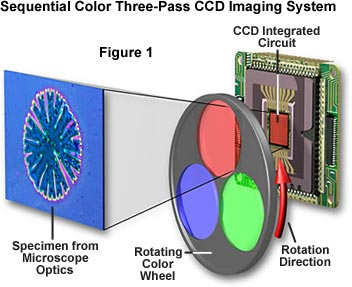Concepts in Digital Imaging Technology
Sequential Three-Pass Color CCD Imaging
Three-pass sequential color CCD imaging systems employ a rotating color wheel to capture three successive exposures in order to obtain the desired RGB (red, green, and blue) color characteristics of a digital image. The major advantage of this technique is the ability to fully utilize the entire pixel array of a CCD imaging chip, by using one pass for each color.

Silicon based charge-coupled devices lack the ability to distinguish color information presented to the pixel elements by incoming photons. Even though electromagnetic radiation of varying energy passes through the devices to a depth determined by the wavelength, the interaction that produces free elections and holes is not color sensitive. A typical sequential color imaging system design is illustrated in Figure 1, which shows the red filter being used to pass illuminating light waves from the microscope optics to the CCD surface. The primary advantage of this technique is the ability to achieve the highest resolution capable of the device, which equals the size of the CCD array.
After all of the image information has been captured in three individual passes, it is recombined off-chip and processed in a manner similar to that of other CCD architectures. The major disadvantage of this system is the relatively long exposure times necessary to accumulate three individual color arrays, which requires an almost stationary subject and vibration-free operation of the rotating color wheel mechanical components. This technique is being slowly phased out as single-shot CCD cameras with higher resolutions become commonplace. However, a number of applications now incorporate a rapidly switchable liquid crystal array screen that can be used to capture the three colors in milliseconds, thus speeding the throughput of the device and reducing the risk of mechanically-induced vibration.
Contributing Authors
Mortimer Abramowitz - Olympus America, Inc., Two Corporate Center Drive., Melville, New York, 11747.
Michael W. Davidson - National High Magnetic Field Laboratory, 1800 East Paul Dirac Dr., The Florida State University, Tallahassee, Florida, 32310.
BACK TO CONCEPTS IN DIGITAL IMAGING TECHNOLOGY
